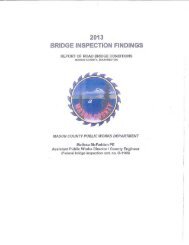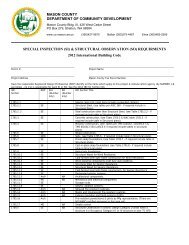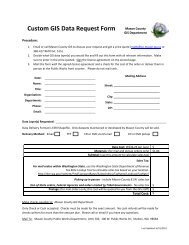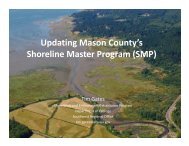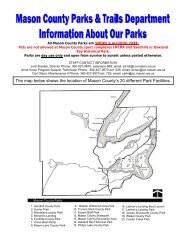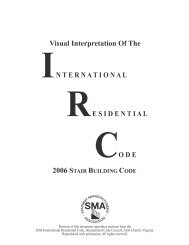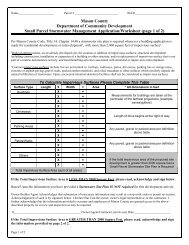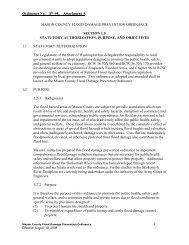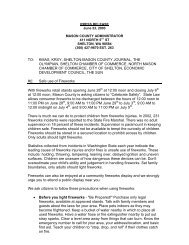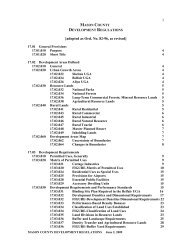hazard identification and vulnerability analysis - Mason County
hazard identification and vulnerability analysis - Mason County
hazard identification and vulnerability analysis - Mason County
You also want an ePaper? Increase the reach of your titles
YUMPU automatically turns print PDFs into web optimized ePapers that Google loves.
Hazard Identification <strong>and</strong> Vulnerability Assessment<br />
Much of the recent development in the <strong>County</strong> has occurred either in or near<br />
flood plains. This development increases the likelihood of flood damages in two<br />
ways. First, new developments near a flood plain add structures <strong>and</strong> people in<br />
flood areas. Secondly, new construction alters surface water flows by diverting<br />
water to new courses or increases the amount of water that runs off impermeable<br />
pavement <strong>and</strong> roof surfaces. This second effect diverts waters to places that<br />
were previously safe from flooding.<br />
In years past, people living on or near rivers have taken it upon themselves to<br />
remove gravel deposits thus helping to maintain river <strong>and</strong> stream channels. As<br />
greater emphasis has been placed on maintaining salmon spawning areas, this<br />
type of activity is now restricted <strong>and</strong> requires hydraulic permits for any activity in<br />
the riverbeds. As a result, deposits of gravel have built up over the years, <strong>and</strong><br />
the river channels have become increasingly shallow, exacerbating the chances<br />
of flooding. Low dikes constructed along the Skokomish failed in the December<br />
2007 winter storm.<br />
<strong>Mason</strong> <strong>County</strong> will always be vulnerable to flooding, especially in Skokomish<br />
Valley, Tahuya River Valley <strong>and</strong> along the Satsop River.<br />
Conclusions<br />
Mitigation involves flood plain planning, buyout of flood prone residences,<br />
elevation of homes <strong>and</strong> management coordinated by local, state <strong>and</strong> federal<br />
agencies. Building codes <strong>and</strong> regulations applied to structures aid in mitigation.<br />
Residents should have access to information on flood insurance. Where building<br />
has already occurred on flood plains, emergency preparedness in the form of<br />
s<strong>and</strong>bags, building materials, 3-day evacuation kits <strong>and</strong> alternate shelter should<br />
be part of each resident's preparation for possible flooding.<br />
Resources<br />
Federal Emergency Management Agency<br />
National Weather Service<br />
United States Army Corps of Engineers, Northwest Division<br />
Washington State Emergency Management Division<br />
Western Regional Climate Center<br />
Attachments<br />
Skokomish River Basin Map<br />
Tahuya River Basin Map<br />
Satsop River Basin Map<br />
19



